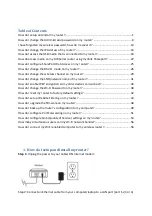
ESSID:
The unique identifier that identifies the ESS. In infrastructure
association, the stations use the same ESSID as AP’s to get connected.
Ethernet:
A popular local area data communications network, originally
developed by Xerox Corp., that accepts transmission from computers and
terminals. Ethernet operates on a 10/100 Mbps base transmission rate, using
a shielded coaxial cable or over shielded twisted pair telephone wire.
Fragmentation:
When transmitting a packet over a network medium,
sometimes the packet is broken into several segments, if the size of packet
exceeds that allowed by the network medium.
Fragmentation Threshold:
The Fragmentation Threshold defines the number
of bytes used for the fragmentation boundary for directed messages. The
purpose of "Fragmentation Threshold" is to increase the transfer reliability thru
cutting a MAC Service Data Unit (MSDU) into several MAC Protocol Data Units
(MPDU) in smaller size. The RF transmission can not allow to transmit too big
frame size due to the heavy interference caused by the big size of transmission
frame. But if the frame size is too small, it will create the overhead during the
transmission.
Gateway:
a device that interconnects networks with different, incompatible
communication protocols.
HEX:
Hexadecimal, HEX, consists of numbers from 0 – 9 and letters from A –
F.
IEEE:
The
I
nstitute of
E
lectrical and
E
lectronics
E
ngineers, which is the largest
technical professional society that promotes the development and application of
electrotechnology and allied sciences for the benefit of humanity, the
advancement of the profession. The IEEE fosters the development of standards
that often become national and international standards.
Infrastructure:
An infrastructure network is a wireless network or other small
network in which the wireless network devices are made a part of the network
through the Access Point which connects them to the rest of the network.
ISM Band:
The FCC and their counterparts outside of the U.S. have set aside
bandwidth for unlicensed use in the ISM (Industrial, Scientific and Medical)
band. Spectrum in the vicinity of 2.4GHz, in particular, is being made available
worldwide.
MAC Address:
Media Access Control Address is a unique hex number
assigned by the manufacturer to any Ethernet networking device, such as a
network adapter, that allows the network to identify it at the hardware level.
Multicasting:
Sending data to a group of nodes instead of a single destination.
74
Summary of Contents for 54MBPS WIRELESS LAN POCKET ACCESS POINT
Page 1: ...54Mbps Wireless LAN Pocket Access Point USER MANUAL...
Page 23: ...Now the main menu screen is popup 20...
Page 41: ...PPPoE with a fixed IP address 38...
Page 42: ...PPTP 39...





































